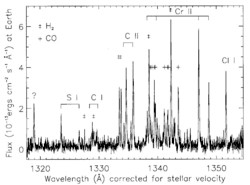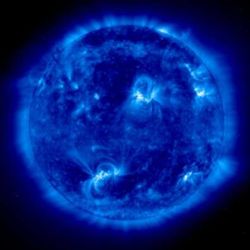Stellar chromospheres, coronae and winds
Cool Stars group: Carole Jordan, Graeme Smith, Eric Houdebine, Stuart SimThe aim of our research is to understand the outer atmospheres of the Sun and other cool stars. Above the photosphere (the visible region which has a black-body temperature of approx. 5800K), the kinetic temperature increases through the chromosphere (where it reaches approx. 10000K) and transition region and into the corona, where it is <= 1000000K.
At high temperatures the gas is ionized and emits mainly in the ultraviolet and X-ray parts of the spectrum, which are absorbed by the Earth's atmosphere, so observations have to be made from satellites. We have made observations of the Sun using spectrometers on the Solar and Heliospheric Observatory (SOHO), and of other cool stars using spectrometers on the Hubble Space Telescope (HST) and the Far Ultraviolet Explorer (FUSE) and other satellites. Recent X-ray spectra are available from the Chandra and XMM-Newton satellites.
Main-sequence stars and G-type giants
Observations of other main-sequence stars and G-type giant stars indicate that the properties of their outer atmospheres are related to the stellar rotation rate and conditions near the base of the convection zone below the photosphere, where magnetic fields are generated by dynamo action. We are using computer codes to model the outer atmospheres of such stars to elucidate what controls their structure and heating.
Active binary stars
Work on HR 1099 etc.
 |
| Fig. 2: A segment of the
ultraviolet spectrum of the giant star Aldebaran (alpha Tau). The
spectrum shows many emission lines including sets of fluorescent lines
of carbon monoxide (CO), molecular hydrogen (H2) and
ionized iron (FeI). Credit: McMurry & Jordan (2000), MNRAS, 313, 423 |
Cool giant stars
Cooler giants (types mid-K and M) and most supergiant stars do not show X-ray emission from a hot corona, and in parts of their chromospheres, sound waves rather than magnetic waves are likely to cause heating. Our observations from the HST show that the ultraviolet spectra of such stars contain many emission lines of ionized iron (Fe II), molecular hydrogen (H2) and carbon monoxide (CO) (see Fig. 2) which are excited by emission in strong lines of hydrogen and oxygen.
This fluorescence is thought to arise when emission from shock-heated regions within the atmosphere penetrates into surrounding cooler material. Comparative studies of several such stars are planned.
Solar studies
Work on helium lines etc using SOHO.
References
Macpherson K. P., Jordan C., Smith G. R., The anomalous intensities of helium lines in a coronal hole, 2001, MNRAS, in press
Jordan C., Sim S. A., McMurry A. D., Aruvel M., The electron pressure indent in the outer atmosphere of &epsilon Eri (K2 V), 2001, MNRAS, in press
Sim S. A., Modelling the H Lyman lines in evolved late-type stars, 2001, MNRAS, in press
Harper G. M., Wilkinson E., Brown A., Jordan C., Linsky J. L., Identification of Fe II emission lines in FUSE stellar spectra, 2001, ApJ, 551, 486-494
Jordan C., McMurry A. D., Sim S. A., Aruvel M., Detection of magnetic dipole lines of Fe XII in the ultraviolet spectrum of the dwarf star &epsilon Eri, 2001, MNRAS, 32, L5-L9
Jordan C., Current understanding of the heating of the solar corona, 2000, Plasma Phys. Control. Fusion, 42, 415- 434
Past theses
Smith G. R., 2001, A study of helium I and II lines in the solar atmosphere.
Amaya T., 2000, Knots and helicity
McMurry A. D., 1997, Radiative transfer in stellar chromospheres.
Rowe A. K., 1996, Ca II lines in the solar atmosphere.
Griffiths N. W., 1996, Coronal and transition region structure in the RS CVn binaries V711 Tau, AR Lac and II Peg.
Philippides D. A., 1996, Models of the transition regions and coronae of late-type stars.

